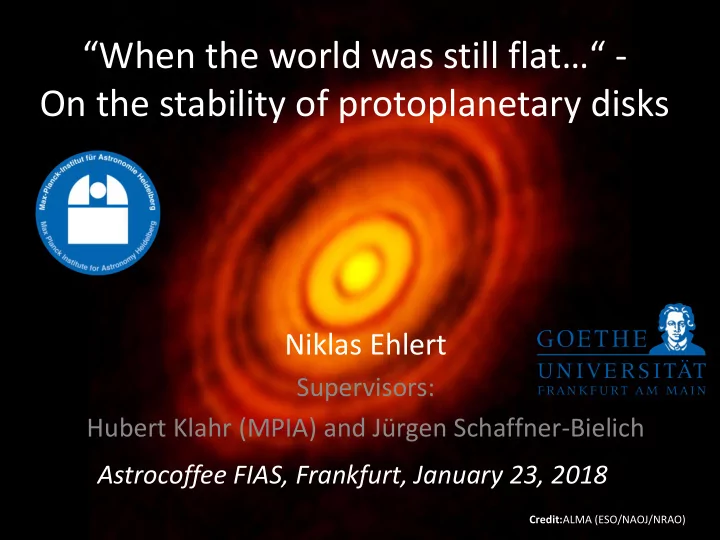

“ When the world was still flat…“ - On the stability of protoplanetary disks Niklas Ehlert Supervisors: Hubert Klahr (MPIA) and Jürgen Schaffner-Bielich Astrocoffee FIAS, Frankfurt, January 23, 2018 Credit: ALMA (ESO/NAOJ/NRAO)
Source: https://www.youtube.com/watch?v=E4yirtvUurA (January 5, 2018, 22:20 h) January 23, 2018 Niklas Ehlert 2
Credit: NASA Credit: ALMA (ESO/NAOJ/NRAO) size: ~ ⋅ 10 13 mass: ~ ⋅ 10 40 Credit: NASA Johnson Space Center Credit: NASA/JPL/University of Arizona January 23, 2018 Niklas Ehlert 3
Topics Content-wise: Protoplanetary disks • properties • evolution Method-wise: Linear Stability Analysis January 23, 2018 Niklas Ehlert 4
Assumptions • 𝑁 𝑒𝑗𝑡𝑙 ≪ 𝑁 ∗ • scale height ℎ satisfies ℎ 𝑠 ≪ 1 𝑁 𝑒𝑗𝑡𝑙 1 ℎ • neglect self-gravity < 𝑠 (Toomre criterion) 𝑁 ∗ 2 • “passive disks” → heated by central star ≤ 2 ⋅ 10 −8 𝑁 𝑡𝑣𝑜 → slow accretion rates ( 𝑁 𝑧𝑠 ) → late times in disk evolution January 23, 2018 Niklas Ehlert 5
Disk evolution • angular momentum must be transported: → winds → viscosity 𝜉 • Navier-Stokes equation yields: 𝜖Σ 𝜖𝑢 = 3 𝜖 2 𝜖 1 𝜖𝑠 (𝜉Σ𝑠 1/2 ) 𝜖𝑠 𝑠 𝑠 • Shakura & Sunyaev (1973) • Lynden-Bell & Pringle (1974) January 23, 2018 Niklas Ehlert 6
Disk evolution equation 𝜖Σ 𝜖𝑢 = 3 𝜖 2 𝜖 𝑌 = 2𝑠 1/2 1 𝜖𝑠 (𝜉Σ𝑠 1/2 ) 𝜖𝑠 𝑠 𝑠 3 2 Σ𝑌 = 3Σ𝑠 1/2 𝑔 = 𝐸 = 12𝜉 𝑌 2 = 3𝜉 𝜖𝑢 = 𝐸 𝜖 2 𝑔 Diffusive form: 𝜖𝑔 𝑠 𝜖𝑌 2 Diffusion time scale: Δ𝑌 2 𝐸 ⇒ viscous time scale: 𝜐 𝜉 ≈ 𝑠 2 𝜉 January 23, 2018 Niklas Ehlert 7
Viscosity? • 𝛽 -prescription: 𝜉 = 𝛽𝑑 𝑡 ℎ 𝑑 𝑡 • Molecular collisions: 𝜉 𝑛 ~𝜇𝑑 𝑡 = 𝑜𝜏 ⇒ 𝜐 𝜉 = 𝑠 2 ≈ 3 ⋅ 10 13 𝑧𝑠 𝜉 𝑛 𝑉𝑀 𝑑 𝑡 ℎ 𝜉 𝑛 ~10 10 ≫ 1 • Reynolds number: 𝑆𝑓 = 𝜉 𝑛 = ⇒ highly turbulent IF there is an instability January 23, 2018 Niklas Ehlert 8
Rayleigh criterion A non-self-gravitating, non-magnetized disk flow is linearly stable to axisymmetric perturbations if 𝑒𝑚 𝑒𝑠 𝑠 2 Ω > 0 𝑒𝑠 = 𝑒 Ω ∝ 𝑠 −3/2 ⇒ no turbulence?! January 23, 2018 Niklas Ehlert 9
Magnetorotational Instability • Chandrasekhar 1961, Balbus & Hawley 1991 𝑒Ω 2 • Modified stability condition: 𝑙𝑤 𝐵 2 + 𝑒ln 𝑠 > 0 [1] January 23, 2018 10
Dead zones [1] January 23, 2018 Niklas Ehlert 11
Hydrodynamical Instabilities Gravitational Subcritical Critical Layer Instability Instability Baroclinic Instability Streaming Instability? Vertical Shear Instability Convective Goldreich- Overstability Schubert-Fricke Instability January 23, 2018 Niklas Ehlert 12
Convective Overstability • neglect vertical structure: 𝛾 𝑟 𝛾 𝑞 𝑆 𝑆 2 = 𝑑 𝑡 2 ⋅ 2 𝜍 𝜍 0 = 𝜍 0 ⋅ , 𝑑 𝑡 , 𝑞 = 𝑑 𝑡 𝑆 0 𝑆 0 • Consider thermal relaxation: 𝑇 = 𝑞 𝑈−𝑈 0 𝑈 𝜐 𝜐 → 0 : locally isothermal limit 𝜐 → ∞ : adiabatic limit January 23, 2018 Niklas Ehlert 13
Worst slide in this talk … 𝜖 𝑢 (𝜍 0 + 𝜍′) + 𝜍 0 + 𝜍′ 𝜖 𝑦 𝑣′ + 𝑣′ 𝜖 𝑦 (𝜍 0 + 𝜍′) = 0 1 𝜖 𝑢 𝑣′ + 𝑣′ 𝜖 𝑦 𝑣′ + 𝜍 0 + 𝜍′ 𝜖 𝑦 (𝑞 0 + 𝑞′) + 𝜖 𝑦 Φ = 0 𝜖 𝑢 𝑞 0 + 𝑞′ + 𝑣′ 𝜖 𝑦 (𝑞 0 + 𝑞′) + 𝛿 𝑞 0 + 𝑞′ 𝜖 𝑦 𝑣′ = 0 𝜖 𝑢 𝜍′ + 𝜍 0 𝜖 𝑦 𝑣′ + 𝑣′ 𝜖 𝑦 𝜍 0 = 0 𝜖 𝑢 𝑣 ′ + 𝜖 𝑦 𝑞 ′ − 𝜍 ′ 2 𝜖 𝑦 𝑞 0 = 0 𝜍 0 𝜍 0 𝜖 𝑢 𝑞 ′ + 𝑣 ′ 𝜖 𝑦 𝑞 0 + 𝛿 𝑞 0 𝜖 𝑦 𝑣 ′ = 0 January 23, 2018 Niklas Ehlert 14
Dispersion relation January 23, 2018 Niklas Ehlert 15
Eigenvectors ′ , 𝑞 ′ 𝑈 𝑁 𝜕 ⋅ 𝒘 = 0 ′ , 𝑣 𝑨 ′ , 𝑣 𝜚 𝒘 = 𝜍 ′ , 𝑣 𝑠 growth rate ⇒ [3] overstable epicycle January 23, 2018 Niklas Ehlert 16
January 23, 2018 Niklas Ehlert 17
Numerical Simulations • test non-linear instabilities • PLUTO code (Mignone et al.): – discretization, static or adaptive mesh – finite volume or finite difference approach – 1D, 2D or 3D simulations • shows vortex formation and growth January 23, 2018 Niklas Ehlert 18
Summary Pp-disks are turbulent. MRI creates turbulence , but… … there are dead Credit: ALMA (ESO/NAOJ/NRAO) zones, where … … hydrodynamic Credit: N. Raettig instabilities operate ... … under baroclinic conditions and finite cooling times to create vortices. January 23, 2018 Niklas Ehlert 19
Next talk in about 6 months … Thank you and stay tuned! January 23, 2018 Niklas Ehlert 20
Summary Pp-disks are turbulent. MRI creates turbulence , but… … there are dead Credit: ALMA (ESO/NAOJ/NRAO) zones, where … … hydrodynamic Credit: N. Raettig instabilities operate ... … under baroclinic conditions and finite cooling times to create vortices. January 23, 2018 Niklas Ehlert 21
Sources [1] Philip J. Armitage : „ Astrophysics of Planet Formation “, Cambridge University Press, New York, USA, 2013 [2] https://upload.wikimedia.org/wikipedia/ commons/d/d4/Johannes_Kepler_1610.jpg (January 6, 2018, 19:05 h) [3] Lyra W., 2014, ApJ, 789, 77 January 23, 2018 Niklas Ehlert 22
Backup January 23, 2018 Niklas Ehlert 23
January 23, 2018 Niklas Ehlert 24
Recommend
More recommend